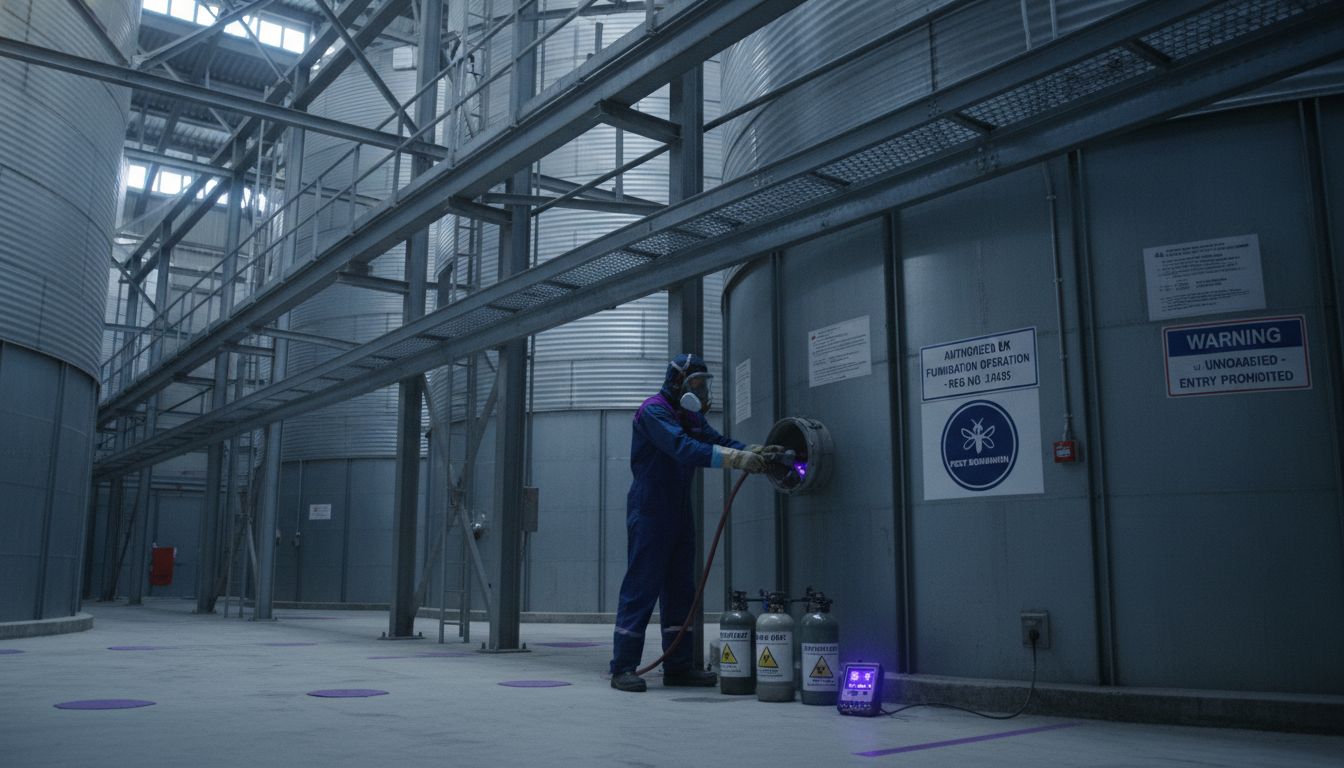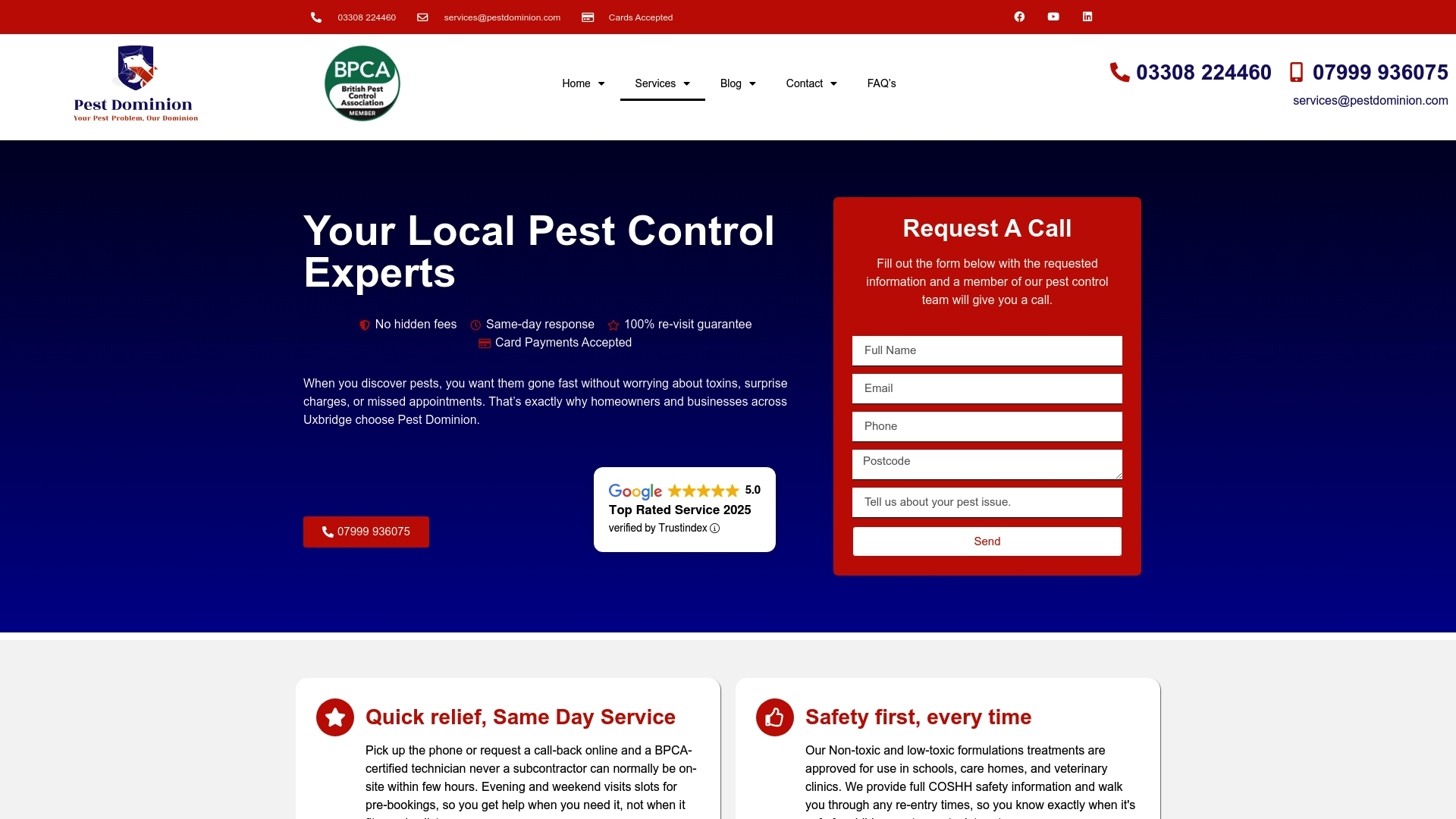Over 14 million UK homes and businesses face costly pest infestations each year, a challenge that can threaten health and property. Fumigation stands out as a powerful tool for tackling even the most hidden invaders. Whether you manage a farm, run a warehouse, or care for a family home, understanding how fumigation works can make a real difference when standard treatments fail and complete eradication matters most.
Table of Contents
- Fumigation Explained: Definition And Core Principles
- Types Of Fumigation: Methods And Applications
- How The Fumigation Process Works In Practice
- Legal Standards And Uk Compliance Requirements
- Risks, Safety Measures, And Alternatives
Key Takeaways
| Point | Details |
|---|---|
| Fumigation Overview | Fumigation is an effective pest control method that uses gaseous chemicals to eliminate pests in various enclosed spaces. |
| Types of Fumigation | Methods include structural, commodity, and soil fumigation, each tailored to specific environments and pest challenges. |
| Legal Compliance | Fumigation in the UK requires adherence to strict legal standards, including risk assessments and safety protocols. |
| Safety Protocols | Implementing robust safety measures is crucial to mitigate risks associated with toxic exposure during fumigation. |
Fumigation Explained: Definition and Core Principles
Fumigation is a sophisticated pest control method that utilises specialised gaseous chemicals to eradicate unwanted organisms from enclosed spaces. According to research from the Health and Safety Executive (HSE), this technique involves filling an area with potent fumigant gases designed to suffocate or poison targeted pests comprehensively.
The process is incredibly versatile, targeting infestations across multiple environments. Understanding the Role of Fumigation in Property Care reveals that fumigation can be applied in diverse settings including:
- Residential buildings
- Commercial premises
- Shipping containers
- Agricultural storage facilities
- Industrial processing areas
At its core, fumigation works by introducing gaseous pesticides that penetrate deeply into materials, reaching pests in hard-to-access locations where traditional treatments might fail. The effectiveness depends on carefully selected fumigants matched to specific pest types, environmental conditions, and the particular space being treated. Professional pest control specialists assess multiple factors like temperature, pest species, and structural characteristics to determine the most appropriate fumigation approach.
The strategic application ensures complete pest elimination while minimising potential risks to human health and property. Proper implementation requires extensive expertise, specialised equipment, and strict adherence to safety protocols to guarantee successful treatment and prevent potential recontamination.
Types of Fumigation: Methods and Applications
Fumigation techniques are highly specialised and vary significantly depending on the specific environment and pest challenge. According to research from the Health and Safety Executive (HSE), these methods can be broadly categorised into several key approaches that target different contexts and pest control requirements.
Structural Fumigation represents one of the most comprehensive techniques, designed to treat entire buildings or enclosed spaces. This method involves:
- Completely sealing the target area
- Introducing potent gaseous pesticides
- Ensuring thorough penetration into walls, floors, and hidden spaces
- Eliminating pests across multiple locations within the structure
Commodity Fumigation focuses on protecting stored products and materials. Understanding the Role of Fumigation in Property Care highlights this method’s critical importance in preventing pest spread during storage and transportation. It is particularly crucial in:
- Agricultural grain storage
- Food processing facilities
- Import/export shipping containers
- Warehouse inventory management
Soil Fumigation represents another sophisticated approach, primarily used in agricultural settings to combat underground pest populations and plant diseases. Professional pest control specialists apply specialised gases that penetrate soil layers, creating an inhospitable environment for harmful organisms.

Each fumigation method requires precise technical expertise, carefully selected fumigants, and strict adherence to safety protocols. The ultimate goal remains consistent: comprehensive pest elimination while minimising potential risks to human health and environmental systems.
Here’s a comparison of the principal fumigation methods:
| Method | Typical Applications | Main Advantages | Special Considerations |
|---|---|---|---|
| Structural Fumigation | Residential buildings Commercial sites Industrial units |
Comprehensive whole-site treatment | Requires full building evacuation Extended preparation time |
| Commodity Fumigation | Grain silos Shipping containers Warehouses |
Protects stored goods Prevents spread during transit |
Product compatibility with chemicals Strict residue limits |
| Soil Fumigation | Agricultural land Greenhouses |
Targets soil-borne pests Increases crop yield |
Potential impact on soil biology Timing critical for planting |
How the Fumigation Process Works in Practice
According to the Health and Safety Executive (HSE), the fumigation process is a meticulously planned and carefully executed pest control strategy that involves several critical stages.
Professional fumigation requires precision, expertise, and strict adherence to safety protocols to ensure comprehensive pest elimination.
The process typically unfolds through a systematic sequence of steps:
- Pre-Fumigation Preparation
- Comprehensive property inspection
- Identifying specific pest challenges
- Determining appropriate fumigation method
- Selecting suitable fumigant chemicals
- Site Preparation and Isolation
- Complete evacuation of humans and animals
- Sealing all potential gas escape points
- Covering or removing sensitive items
- Creating a controlled, enclosed environment
Understanding the Role of Fumigation in Property Care emphasises the importance of precise environmental control during this critical phase. Professional technicians carefully calculate gas concentration, exposure duration, and penetration requirements to maximise pest eradication.
The final stages involve meticulous monitoring and clearance. After the designated exposure period, specialists conduct thorough ventilation, using specialised equipment to measure gas levels and ensure the space is safe for reoccupation. This comprehensive approach guarantees not just pest elimination, but also the safety of inhabitants and the integrity of the treated environment.
Legal Standards and UK Compliance Requirements
Fumigation activities in the United Kingdom are governed by stringent legal frameworks designed to protect public health and safety. According to the Health and Safety Executive (HSE), the primary regulatory mechanism is the Control of Substances Hazardous to Health Regulations 2002 (COSHH), which establishes comprehensive guidelines for managing potentially dangerous chemical treatments.
Key legal compliance requirements for fumigation professionals include:
- Conducting thorough risk assessments before any treatment
- Implementing rigorous control measures
- Ensuring comprehensive staff training
- Maintaining detailed operational documentation
- Using appropriate personal protective equipment (PPE)
- Verifying chemical storage and handling protocols
Understanding the Role of Fumigation in Property Care emphasises that legal compliance is not just about following rules, but protecting people and environments. Professional fumigators must demonstrate:
- Certification of competence
- Evidence of professional training
- Comprehensive insurance coverage
- Adherence to environmental protection standards
Beyond COSHH regulations, fumigation professionals must also navigate additional legal frameworks, including environmental protection legislation, workplace safety guidelines, and specific industry-related standards. The complexity of these requirements underscores the critical importance of working with certified, experienced pest control specialists who understand the intricate legal landscape surrounding chemical pest management.
Risks, Safety Measures, and Alternatives
Chemical fumigation presents significant potential hazards that demand meticulous professional management. According to the Health and Safety Executive, these treatments involve toxic substances that can be fatal if not executed with extreme precision and care, making comprehensive safety protocols absolutely critical.
Key risks associated with fumigation include:
- Potential toxic exposure to humans and animals
- Risk of chemical contamination
- Potential long-term environmental impact
- Respiratory and neurological health dangers
- Potential property damage if improperly conducted
Risk Assessment Policy highlights the importance of implementing robust safety measures. Professional pest control specialists must ensure:
- Complete area evacuation
- Use of advanced protective equipment
- Precise chemical concentration monitoring
- Thorough post-treatment ventilation
- Comprehensive environmental and health risk assessments
For those seeking alternatives, modern pest management offers several less invasive options. Alternative treatments such as heat treatment, cold treatment, and controlled atmospheric interventions provide effective pest control with reduced chemical exposure. These methods offer targeted solutions that minimise environmental and health risks while maintaining the same high standards of pest elimination that traditional fumigation provides.
Expert Fumigation Solutions for Your Property Needs
Fumigation is a powerful but complex process that tackles persistent pest problems by using specialized gases to eliminate infestations in structures, stored goods, or soil. If you are concerned about complete pest eradication that is safe, effective, and compliant with UK regulations , it is crucial to work with specialists who understand the delicate balance between thorough treatment and safety. Professional fumigation requires careful site preparation, precise chemical application, and strict adherence to health and safety standards to protect your property and loved ones.

At Pest Dominion Limited , we provide expert fumigation and pest control services tailored to the specific challenges faced by your home or business. Serving Slough and nearby areas, our local team offers fast, reliable, and environmentally conscious solutions that put your peace of mind first. Discover how our certified experts ensure the safest treatment methods that comply fully with legal requirements by visiting our main website. Learn more about how our extensive range of comprehensive services can solve your pest challenges or contact us today for a clear, transparent quote designed around your needs.
Frequently Asked Questions
What is fumigation and how does it work?
Fumigation is a pest control method that uses gaseous chemicals to eliminate pests from enclosed spaces, penetrating deeply into materials to reach those in hidden locations.
What are the different types of fumigation methods?
The primary fumigation methods include structural fumigation, which treats entire buildings; commodity fumigation, focused on protecting stored products; and soil fumigation, used primarily in agriculture to target underground pests.
What safety measures are necessary during the fumigation process?
Key safety measures include complete area evacuation, use of protective equipment, monitoring chemical concentrations, and thorough post-treatment ventilation to ensure safety for inhabitants and the environment.
What are the potential risks associated with fumigation?
Potential risks include toxic exposure to humans and animals, chemical contamination, respiratory and neurological health dangers, and environmental impacts if safety protocols are not strictly followed.
Recommended
- Understanding the Role of Fumigation in Property Care – Pest Dominion, Your Local Pest Control Services
- Pest Control Explained: Protecting Health and Property – Pest Dominion, Your Local Pest Control Services
- 7 Best Pest Prevention Products for Your Property – Pest Dominion, Your Local Pest Control Services

